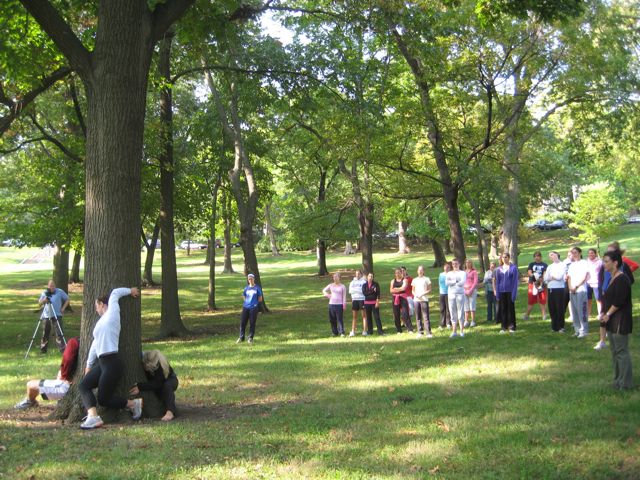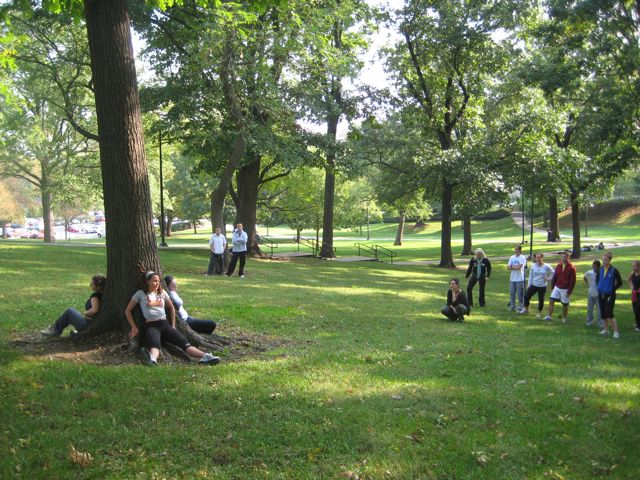

The observing students and Michelle H. joke about the “Wild Kingdom” aspect of being observed in their natural habitat. Michelle H. says - Look at the academics documenting the dancers in the wild. “This is the most dangerous type of dancer,” one student says in a Crocodile Hunter voice. Have they have forgotten that I’m standing right behind them and writing down everything they say? I giggle a little – irony is funny. (From Michelle's notes, day 1)

Note 2: I accidentally make eye contact with a dancer. We smile. Was this a mistake? It reminds me that I have physical presence, even behind my notebook. (from Sherrie's notes, day 1).
Observers: Rich is in the back of the group with a still camera. Pete and Michelle are orbiting the dancers while they are warming up. I'm wearing my University of Idaho Marching Band baseball hat and my red KU t shirt and I'm sitting on some concrete stairs. Sherrie's up against a tree, and kind of following the dance warmup - it's funny to watch her attempt the tree pose while taking notes. Rich then grabs the video camera and is attentively and carefully adjusting his camera - he knows what he wants the result to be and he knows how to manipulate his equipment to get the desired effect. (Chris's notes 9/29/08)
I move to the front of the group of dancers who are still warming up to look at their facial expressions. The dancers are wearing a variety of clothing: tight pants, shorts, sweatpants, sweatshirts, long or shirt sleeve t shirts, and all different colors. I wonder: do the dancers feel comfortable, nervous with us watching them and recording what they're doing? They mostly seem to be unaware of us, or not even caring - so they probably feel ok with us here.I move to the front of the group of dancers who are still warming up to look at their facial expressions. The dancers are wearing a variety of clothing: tight pants, shorts, sweatpants, sweatshirts, long or shirt sleeve t shirts, and all different colors. I wonder: do the dancers feel comfortable, nervous with us watching them and recording what they're doing? They mostly seem to be unaware of us, or not even caring - so they probably feel ok with us here. (Chris's notes 9/29//8)
During the improv Michelle H. comments to the observer group on how the "artificial frolicking is really weird." To which I think she's talking about this reliance on dance vocabulary. (chris's notes 9/29/8)
The second group begins the same activity. Group 1 is now on the sidewalk, watching. This second group spreads wider than the first. They begin to interact with the trees sooner as well. Has watching someone else perform the task and discussing it modified their behavior? If they had gone first would they have done the same? How much of their behavior is a result of the guidence and direction? (Michelle's notes, 9/29)
Michelle wants to repeat the activity, and points to three trees. She asks for the students who were at those trees during the first round of this activity to return to them. There seems to be some reluctance to admit who was at those trees, with the knowledge that they will then have to perform for the rest of the class to watch. Eventually, the trees are repopulated: two students at the tree to my left, three in the middle and three to the right. The rest of the class observes, and while the highlighted groups are performing, the observers are fairly quiet. (Michelle's notes, 9/29)
The students who are watching seem to be brainstorming what they will do when it is there next turn. “What if we had…?” “Oh, did you see that?!” That movement there is “because of the cold.” Pointing out a student who is on the sculpture: “That’s Matt.” They are trying to identify who is doing what, even though from this distance it’s somewhat hard to tell. They seem to be pointing out classmates who are doing something that they like or find interesting. (Michelle's notes, 10/1)
Rich runs right up the hill with video camera in hand, which then immediately think of that scene in the Big Lebowski when Walter jumps out of the Dude's car and screams "lets take that hill," like he was back in 'Nam or something. Anyway, Rich and the other dancers took that hill with gusto. (Chris's notes, 9/29/8)
Observers (AMS) and innocent bystanders ams observers and bystanders.mp2
AMS observer effect AMS observer effect.mp2
--I note that I wished I could ask dancers to do some movements again so I could capture them on camera (from Pete's notes, day 1)
--I feel more strongly today that I need a video camera to capture improv here. Still photos just don’t show movement. But this gets me thinking about trying to capture improv in the first place. What is being captured by all of us and what isn’t? There’s a space with boundaries, but so much is going on in that space that not all of it can be “captured.” I feel like getting motion on camera will help. Sherrie says she likes the close-up pictures of the textures of trees, so I decide to get closer to dancers with the video camera. (from Pete's notes, day 2)